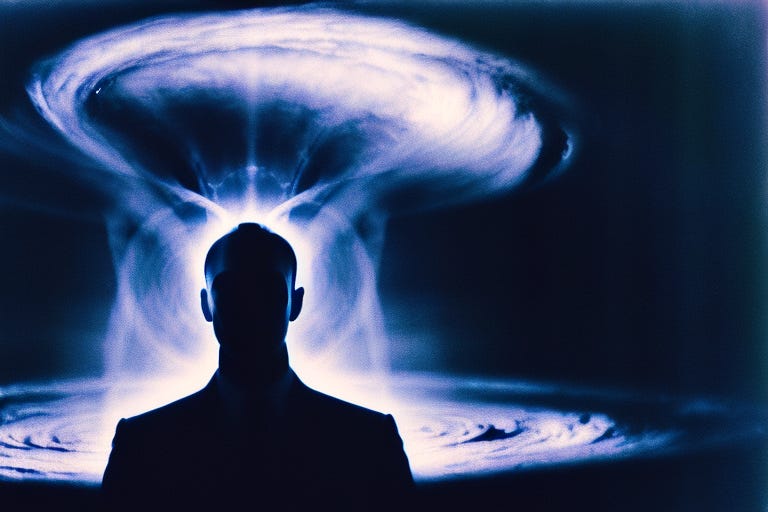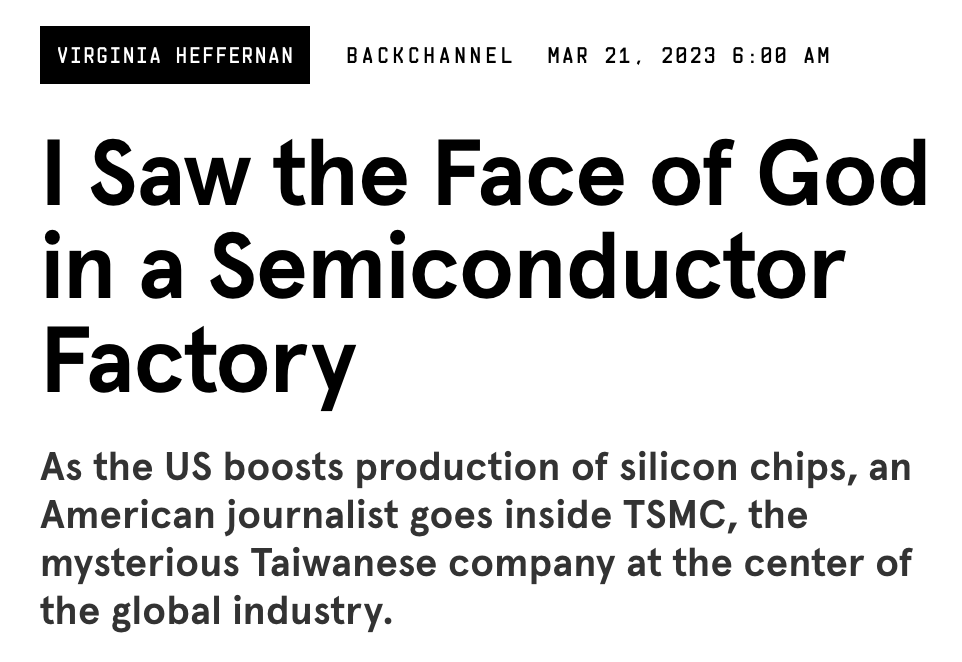Avoid the Void
Resist the sentimental temptation to think technology can show you the face of God.
Some might suppose it’s coincidence that this weekend, in the wake of Starship’s humbling incineration, I’ll be delivering remarks, at a private seminar, on a tweet inspired by Nick Land’s “Lure of the Void” — the essay that made me want to write about tech again after my second book proposal, about our spiritual preconditions for going to Mars, was universally rejected (by the top New York publishing houses).
At least by the standards of the past two thousand years, it’s nothing special to say that oblivion has a siren call and obeying it, well, don’t do that. But these past few years are special. Second look at the void?
This time, it’s not to chase down the pervy Lovecraftian pleasures of annihilation or insanity. It’s to find the ultimate in meaning, the creation of something from nothing, a presumptively final proof that we have met God and he is us.
You might think there’s not much link between fake news / misinformation / propaganda and the new lure of the void. You would be wrong.
This remarkable piece of propaganda — on whose behalf? I’ll leave you to wonder — begins with a thick slice of cyborg theology.
This is my pilgrimage to the Sacred Mountain of Protection. The Sacred Mountain is reckoned to protect the whole island of Taiwan—and even, by the supremely pious, to protect democracy itself, the sprawling experiment in governance that has held moral and actual sway over the would-be free world for the better part of a century. The mountain is in fact an industrial park in Hsinchu, a coastal city southwest of Taipei. Its shrine bears an unassuming name: the Taiwan Semiconductor Manufacturing Company.
The protection of course is against mainland China, ostensibly menacing the island as a whole, and all the human life therein, although on closer inspection it’s the cyborg life, stupid:
The silicon microchips fashioned inside them are the sine qua non of the built world, so essential to human life that they’re often treated as basic goods, commodities. […] But unlike copper and alfalfa, chips aren’t raw materials. Perhaps they’re currency, the coin of the global realm, denominated in units of processing power. Indeed, just as esoteric symbols transform banal cotton-linen patches into dollar bills, cryptic latticework layered onto morsels of common silicon—using printmaking techniques remarkably similar to the ones that mint paper money—turns nearly valueless material into the building blocks of value itself. This is what happens at TSMC.
No borg, no life! Perhaps, one suddenly speculates, Beijing is actually disinclined to blow up their own all-but-only source of value itself? What, exactly, then, is “the China threat”…?
A story for another day. To the matter at hand. If chips aren’t “building blocks” of matter, much less “value itself,” out of what do these sacred priests of the planetary cyborg theocracy fabricate them?
(And yes, if you think I’m reaching a little, don’t take it from me, ask Virginia.)
Like money, silicon chips are both densely material and the engine of nearly all modern abstraction, from laws to concepts to cognition itself. And the power relations and global economy of semiconductor chips can turn as mind-boggling as cryptocurrency markets and derivative securities. Or as certain theologies, ones that feature nano-angels dancing on nano-pins.
Ah, now we’re getting somewhere. As I’ve told those with ears to hear on the continuing Human Forever tour, until nearly a handful of years ago the only entities thought capable of filling the spacetime beyond human reach and dimension were spiritual: angels fallen or otherwise. Now, our fabulous fabbed Five Is —
innumerable
invisible
instantaneously
interoperable
information entities —
doing so every instant of every moment of every minute of every day. Where are they? Where did they come from? After describing Taiwan as “trauma-bonded” to Ukraine, Heffernan quotes Jacques Savary’s The Perfect Merchant to attribute to Providence the “fellowship created by commerce” across a globe unevenly dispersed with gifts.
TSMC’s success is built on its singular comprehension of this dispersion of providential gifts. The firm is merrily known as “pure play,” meaning all it does is produce bespoke chips for customer companies.
No malevolent demon-summoning force this. On her telling, the cyborg theocracy is nothing less than a fun so without sin that it divinely saves the world. But, please, where does it come from? “TSMC’s simultaneous invisibility and indispensability to the human race is something that Jensen Huang, the CEO of Nvidia, likes to joke about. ‘Basically, there is air—and TSMC,’ he said at Stanford in 2014.” Not the air itself. Surely not the air…
On arrival, the self-described “pilgrim” receives a striking — or is it — briefing from the company’s chairman and former CEO.
Two qualities, Mark Liu tells me, set the TSMC scientists apart: curiosity and stamina. Religion, to my surprise, is also common. “Every scientist must believe in God,” Liu says.
And if which God is the question on your lips, congratulations.
“We are doing atomic constructions,” Liu tells me. “I tell my engineers, ‘Think like an atomic-sized person.’” He also cites a passage from Proverbs, the one sometimes used to ennoble mining: “It’s the glory of God to conceal matter. But to search out the matter is the glory of men.”
Understood. But the Earth doesn’t exactly hide its sand, the source of silicon. Liu’s doctoral research at UC Berkeley in the 1970s was on the serendipitous ways that ions behave when shot into silicon; he means it’s atoms that God has secreted away. These indestructible treasures have always been buried in matter, awaiting the invention of scanning electron microscopes and scientists with enough assiduity to spend decades on end peering into their atomic eyes. “There’s no way out,” Liu tells me. “You always feel you are scratching the surface. Until, one day, it’s revealed to you.” […] I remember a phrase from the liturgy of my childhood church: gladness and singleness of heart.
A little background. “In my twenties I called myself a moderately devout Episcopalian,” Heffernan has confessed. “I had a sturdy faith, but I went to church only on Easter or Christmas. Then my fiancé, who was raised as an Orthodox Jew and wanted his children to be matrilineally Jewish, asked me to convert before we married. And so at age 33 I began converting to Conservative Judaism. It’s a complex process. As part of the ritual, the rabbi turned me away three times. I had to study the Torah for a year and reject holidays like Christmas.” Sadly enough things went downhill from there.
Converting tore me up inside and caused tension in my marriage. My husband wanted me to try harder; I wanted him to appreciate what I had already done, learned, and given up.
Our marriage ended, and when it did, I went to my rabbi and asked, “What will become of me?” He looked very sad. Eventually I decided to go back to the Episcopal Church. For Episcopalians, conversion can be as simple as accepting Jesus, but because the Jewish conversion was so arduous, I liked the idea of marking the passage back with a ceremony called reconciliation. My priest put his hand on my forehead and said, “You’re forgiven” — for apostasy, or turning my back on my religion — “and you never need to be forgiven again.” I still cry when I think about it.
In coming back to the church, I feel like I have returned home. Now my belief is a blend of Christian contemplative traditions with Eastern meditative practices. And, I know this is trippy, but as someone who has always found a mysticism in the idea of a collective unconscious, I also put faith in the Internet.
Trippy is one word. Where does such perpetual seeking lead — besides away from Christ and his Church?
Describing the chip fab process as “transubstantiation,” Heffernan channels perhaps the one human source of authority in which a twice-lapsed Episcopalian still believes:
The rest of this post is for paid subscribers…
Keep reading with a 7-day free trial
Subscribe to SUCCULENT to keep reading this post and get 7 days of free access to the full post archives.





